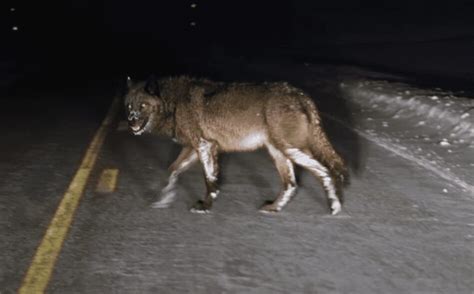
A highly unusual pack of wolverines, numbering at least five individuals, has been captured on trail camera footage in Wyoming’s Gros Ventre Range, a rare sighting that’s exciting wildlife biologists and offering valuable insights into the elusive carnivore’s behavior and social dynamics.
Wildlife advocates are celebrating the extraordinary footage obtained in the Gros Ventre Range of Wyoming, which documents a wolverine family interacting, providing scientists with a rare glimpse into the private lives of these solitary creatures. The images, captured by multiple remote trail cameras, show at least five distinct wolverines, including what appears to be a mother and her offspring, a number far exceeding typical wolverine sightings.
“It’s extremely rare to get a glimpse of wolverines, let alone see a group like this,” said Jeff Smith, a wildlife biologist with the Wyoming Game and Fish Department. “This footage is invaluable for understanding their population dynamics and behavior in Wyoming.”
The wolverine, a powerfully built member of the weasel family, is typically a solitary animal, making such a gathering a notable deviation from observed norms. Adult wolverines are known for fiercely defending vast territories, often exceeding hundreds of square kilometers, and are seldom seen together outside of mating season or when a mother is raising her young.
The trail cameras, strategically placed to monitor wildlife activity in the area, inadvertently captured the wolverine pack over a period of several days. The footage reveals the animals engaging in playful interactions, scent-marking, and foraging activities. Experts believe this extended interaction suggests a family unit, potentially consisting of a mother and her young from multiple litters. The presence of multiple generations within a single group challenges conventional understanding of wolverine social structure.
Wolverines, sometimes called “skunk bears,” have a reputation for ferocity and resilience. They can survive in the harshest of environments, from high-altitude alpine regions to boreal forests. These animals are opportunistic omnivores, feeding on everything from carrion and small mammals to berries and insects. Their powerful jaws and sharp claws allow them to tackle prey much larger than themselves, and their thick fur provides insulation against extreme cold.
The recent sighting highlights the importance of continued wildlife monitoring efforts. Trail cameras are increasingly being used by researchers and conservationists to study animal populations, track movements, and gather data on behavior. These non-invasive tools provide a window into the lives of elusive species like wolverines, offering valuable information that can be used to inform conservation strategies.
“This discovery underscores the importance of protecting wolverine habitat and maintaining connectivity between populations,” stated Dr. Emily Carter, a wolverine researcher at the University of Wyoming. “Habitat fragmentation and climate change pose significant threats to these animals, and understanding their social structure and movement patterns is crucial for ensuring their long-term survival.”
The wolverine population in the contiguous United States has been significantly reduced due to trapping, habitat loss, and climate change. While wolverines are not currently listed as endangered under the Endangered Species Act, they are considered a sensitive species in many states, and conservation efforts are ongoing to protect their populations. The recent sighting in Wyoming provides a beacon of hope for wolverine recovery, demonstrating that these animals can still thrive in suitable habitats.
Further research is planned to study the wolverine population in the Gros Ventre Range and to assess the overall health and distribution of wolverines in Wyoming. This research will involve analyzing DNA samples collected from scat and hair snares, as well as using GPS collars to track the movements of individual animals. The data collected will be used to develop a comprehensive conservation plan for wolverines in Wyoming, ensuring that these iconic animals continue to roam the state’s wild landscapes for generations to come.
Additional Details and Context
The recent sighting of the wolverine pack in the Gros Ventre Range sparks renewed interest in the conservation status of wolverines in the United States. Historically, wolverines roamed across much of the northern United States, including the Great Lakes region and the Northeast. However, trapping and habitat destruction in the 19th and 20th centuries decimated their populations, restricting their range to the high mountains of the West.
Today, wolverines are found in several western states, including Montana, Idaho, Washington, Oregon, and Wyoming. Small, isolated populations may also exist in California, Colorado, and Utah. The total population in the contiguous United States is estimated to be around 300 to 400 individuals, making them one of the rarest and most elusive mammals in North America.
The wolverine’s dependence on snowpack makes it particularly vulnerable to climate change. Wolverines rely on deep, persistent snow for denning and foraging. They build their dens in snowdrifts, where the stable temperature and humidity provide a safe and comfortable environment for their young. Snow also provides insulation for prey species, such as voles and marmots, making them easier for wolverines to hunt.
As climate change causes snowpack to decline and melt earlier in the spring, wolverines are losing critical habitat. Reduced snow cover can lead to den collapse, exposing young wolverines to the elements and increasing their risk of mortality. Warmer temperatures can also alter the distribution of prey species, making it harder for wolverines to find food.
In 2013, the U.S. Fish and Wildlife Service proposed listing wolverines as threatened under the Endangered Species Act, citing the threat of climate change. However, the agency later withdrew the proposal in 2014, citing uncertainty about the severity of the climate change impacts. This decision was challenged in court, and in 2016, a federal judge ordered the Fish and Wildlife Service to reconsider its decision. The agency again declined to list wolverines in 2020, a decision that has been met with renewed legal challenges from environmental groups.
The ongoing debate over the listing of wolverines highlights the challenges of conserving species in the face of climate change. While some argue that the best approach is to focus on reducing greenhouse gas emissions, others advocate for more direct conservation measures, such as habitat protection and translocation.
The sighting of the wolverine pack in Wyoming underscores the importance of protecting existing wolverine habitat. The Gros Ventre Range is a remote and rugged area that provides ideal habitat for wolverines, with its high elevation, deep snowpack, and abundant prey. Conservation efforts in this area should focus on maintaining habitat connectivity, minimizing human disturbance, and managing recreational activities to reduce their impact on wolverine populations.
In addition to habitat protection, translocation may also be a viable option for bolstering wolverine populations in some areas. Translocation involves capturing wolverines from healthy populations and moving them to areas where they are rare or absent. This technique has been used successfully to restore wolverine populations in several European countries, and it could potentially be used to reintroduce wolverines to the Great Lakes region or the Northeast.
The successful reintroduction of wolverines would require careful planning and coordination, as well as extensive public outreach and education. It would also be essential to address the factors that led to the decline of wolverines in the first place, such as trapping and habitat destruction.
The recent sighting of the wolverine pack in Wyoming is a reminder that these resilient animals can still thrive in the wild, given the right conditions. By protecting their habitat, mitigating the impacts of climate change, and exploring innovative conservation strategies, we can ensure that wolverines continue to roam the mountains of the West for generations to come. The unexpected size of this family group hints at a resilience that offers hope for the future of this elusive species.
The Role of Trail Cameras in Wildlife Research
The trail cameras that captured the wolverine pack are a testament to the increasingly crucial role of technology in wildlife research and conservation. These devices, also known as camera traps, are automated cameras equipped with motion sensors that trigger when an animal passes within their field of view. They have become indispensable tools for scientists and conservationists for a variety of reasons:
-
Non-Invasive Monitoring: Trail cameras allow researchers to study wildlife without directly disturbing the animals. This is particularly important for elusive and sensitive species like wolverines.
-
Long-Term Data Collection: Cameras can be deployed for extended periods, gathering data on animal activity patterns, habitat use, and population dynamics. This provides a more comprehensive understanding of wildlife behavior than traditional survey methods.
-
Remote Area Monitoring: Trail cameras can be placed in remote and inaccessible areas, allowing researchers to study wildlife in places that would be difficult or impossible to reach on foot.
-
Cost-Effectiveness: Compared to traditional wildlife survey methods, trail cameras are relatively inexpensive to deploy and maintain. This makes them a cost-effective tool for monitoring wildlife populations over large areas.
-
Public Engagement: Trail camera images and videos can be used to educate the public about wildlife and conservation issues. This can help to build support for conservation efforts and promote responsible wildlife viewing practices.
In the case of the wolverine pack sighting, the trail cameras provided valuable information that would have been difficult to obtain through other means. The footage revealed the presence of multiple wolverines interacting as a family unit, challenging previous assumptions about their social behavior. The data collected from the trail cameras will be used to inform conservation strategies for wolverines in Wyoming and beyond.
The use of trail cameras in wildlife research is constantly evolving, with new technologies and applications being developed all the time. For example, researchers are now using artificial intelligence (AI) to automatically identify animals in trail camera images, saving them countless hours of manual review. They are also developing trail cameras that can transmit data wirelessly, allowing them to monitor wildlife activity in real-time.
As technology continues to advance, trail cameras will undoubtedly play an even greater role in wildlife research and conservation, providing us with a deeper understanding of the natural world and helping us to protect it for future generations. The insights gained from these technologies could revolutionize our understanding of animal behavior, and play a critical role in protecting threatened species.
Threats Facing Wolverines
While the recent sighting offers a glimmer of hope, it’s crucial to acknowledge the persistent threats that wolverines face:
-
Climate Change: As previously mentioned, declining snowpack due to climate change is perhaps the most significant threat to wolverines. Their dependence on snow for denning and prey availability makes them highly vulnerable to warming temperatures.
-
Habitat Loss and Fragmentation: Logging, mining, road construction, and other human activities can fragment wolverine habitat, isolating populations and reducing their access to food and mates.
-
Trapping: Although trapping is now regulated in many areas, wolverines are still occasionally caught in traps set for other animals, such as coyotes and foxes. Illegal trapping also remains a concern.
-
Human Disturbance: Wolverines are sensitive to human disturbance, especially during the denning season. Recreational activities such as snowmobiling and backcountry skiing can disrupt wolverines and lead to den abandonment.
-
Low Population Numbers: Wolverines have naturally low population densities, making them more vulnerable to extinction. Small populations are more susceptible to genetic drift, inbreeding, and stochastic events such as disease outbreaks and natural disasters.
Addressing these threats requires a multi-faceted approach, including:
-
Reducing Greenhouse Gas Emissions: Taking action to combat climate change is essential for protecting wolverines and other snow-dependent species.
-
Protecting and Restoring Wolverine Habitat: Conserving large, contiguous blocks of habitat is crucial for maintaining wolverine populations. This includes protecting existing wilderness areas and restoring degraded habitats.
-
Regulating Trapping: Implementing strict regulations on trapping to minimize the risk of accidental wolverine captures.
-
Managing Human Activities: Managing recreational activities in wolverine habitat to minimize human disturbance, especially during the denning season.
-
Monitoring Wolverine Populations: Continuously monitoring wolverine populations to track their numbers, distribution, and health.
-
Public Education: Educating the public about wolverines and the threats they face can help to build support for conservation efforts.
By addressing these threats, we can help to ensure that wolverines continue to roam the mountains of the West for generations to come. The success of wolverine conservation will depend on the combined efforts of government agencies, conservation organizations, researchers, and the public.
The Wolverine’s Unique Adaptations
The wolverine is a remarkable animal with a number of unique adaptations that allow it to thrive in harsh environments:
-
Powerful Build: Despite its relatively small size (typically weighing between 20 and 40 pounds), the wolverine is incredibly strong and muscular. This allows it to tackle prey much larger than itself and to navigate through deep snow.
-
Thick Fur: The wolverine’s thick, oily fur provides excellent insulation against extreme cold. The fur is also water-resistant, helping to keep the animal dry in wet conditions.
-
Large Paws: The wolverine has large, broad paws that act like snowshoes, allowing it to move easily over deep snow. The paws also have non-retractable claws that provide excellent traction on steep and icy terrain.
-
Powerful Jaws: The wolverine has powerful jaws and sharp teeth that can crush bones and tear through frozen meat. This allows it to scavenge on carcasses and to consume a wide variety of food items.
-
Scent Glands: Wolverines have scent glands that they use to mark their territory and communicate with other wolverines. The scent is strong and musky, and it can be detected over long distances.
-
Opportunistic Diet: Wolverines are opportunistic omnivores, meaning they will eat almost anything they can find, including carrion, small mammals, birds, insects, and berries. This allows them to survive in areas where food is scarce.
-
Tenacity and Aggression: Wolverines are known for their tenacity and aggression. They are fearless animals that will defend themselves against much larger predators, such as bears and wolves.
These adaptations have allowed wolverines to survive in some of the harshest environments on Earth. They are a testament to the power of natural selection and the ability of animals to adapt to challenging conditions. Understanding these adaptations is crucial for appreciating the wolverine’s ecological role and for developing effective conservation strategies.
FAQ Section
1. What is so unusual about seeing a group of wolverines together?
Wolverines are typically solitary animals, fiercely guarding large territories. Seeing a group of five or more, particularly if they appear to be a family unit, is extremely rare. It suggests a potentially unique social dynamic and challenges our understanding of wolverine behavior.
2. Where was this wolverine pack sighted?
The wolverine pack was captured on trail camera footage in the Gros Ventre Range of Wyoming, a remote and rugged mountain area known for its suitable wolverine habitat.
3. Why are wolverines considered a “sensitive species”?
Wolverines are considered a sensitive species due to their low population numbers, dependence on specific habitat conditions (deep snowpack), and vulnerability to threats like climate change, habitat loss, and trapping. Their limited distribution and slow reproductive rate make them particularly susceptible to decline.
4. How are trail cameras helpful in studying wolverines?
Trail cameras provide a non-invasive way to monitor wolverine populations, track their movements, and gather data on their behavior. They can be deployed in remote areas, allowing researchers to study wolverines without disturbing them directly. The images and videos captured can reveal valuable information about their social interactions, foraging habits, and habitat use.
5. What are the main threats to wolverine populations in the United States?
The primary threats to wolverine populations include climate change (specifically, declining snowpack), habitat loss and fragmentation due to human activities (logging, mining, road construction), trapping (both legal and illegal), and human disturbance, particularly during the denning season. These threats can lead to reduced reproductive success, increased mortality, and loss of suitable habitat.









